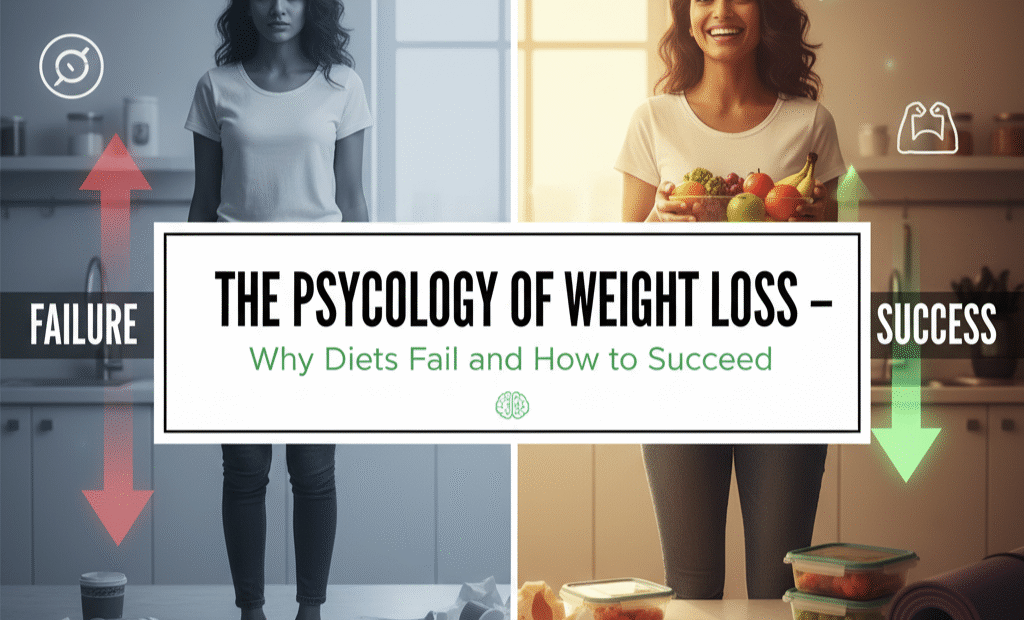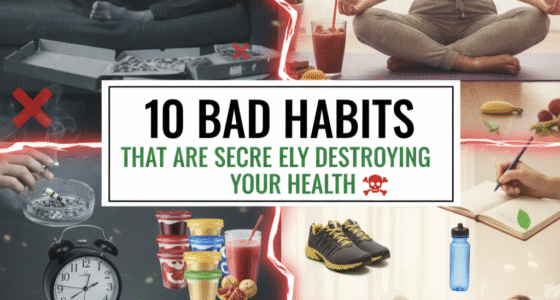A practical, science-informed guide for lasting behavior change, sustainable weight loss, and transforming your relationship with food. Readable, copy-paste friendly HTML for blogs and content platforms.
Introduction
Losing weight is seldom only a physiological problem. For most people who struggle with their weight, the challenge is largely psychological — how we think about food, habit formation, identity, emotions, and environment. Millions start diets every year, but long-term success rates are low. This article explains the psychological mechanisms that cause diets to fail and gives research-backed, pragmatic strategies you can apply immediately to create lasting change. If you’ve tried dozens of diets and kept falling back into old habits, the good news is that success is less about willpower and more about smart design of your environment, routines, and mindset.
Part 1 — Why Diets Fail: The Psychological Traps
1. Unrealistic Expectations and Rapid-Fix Culture
Many modern diet programs advertise dramatic, rapid weight loss. Quick wins can be motivating, but they also shape expectations. When progress slows — as it inevitably does — people feel discouraged. This “speed trap” turns normal physiological plateaus into perceived failure.
2. Restriction, Deprivation and the Rebound Effect
Strict rules about “never” eating certain foods create psychological deprivation. Neuroscience shows that restriction increases the brain’s reward response to forbidden foods, often leading to binge episodes. Extreme calorie restriction also raises hunger hormones like ghrelin, making long-term adherence unlikely.
3. All-or-Nothing Thinking
Cognitive black-and-white thinking — “I ate one cookie so I’ve blown the diet” — converts small slips into abandonment. This thinking pattern amplifies shame and reduces persistence. Habits are built from repeated actions; one mistake isn’t a reversal of identity.
4. Short-Term Mindset vs. Long-Term Behavior Change
Most diets are framed as temporary (for X weeks). Once the diet ends, the person returns to previous routines. Long-term change requires seeing food choices as ongoing lifestyle decisions rather than an episodic challenge.
5. Emotional Eating and Stress Response
Food is a conditioned coping mechanism for many people. Stress, loneliness, boredom, and fatigue trigger automatic eating behaviors. When emotional regulation is not addressed, calorie targets or meal plans do little to stop stress-driven overconsumption.
6. Social and Environmental Pressures
Food is social. Parties, family norms, workplace snacks, and cultural rituals influence choices. If your environment constantly cues overeating, individual willpower becomes a tiny lever compared to environmental design.
Part 2 — The Psychology That Enables Success
1. Motivation vs. Sustained Behavior
Intrinsic motivation (doing something because it aligns with who you want to be) is more durable than extrinsic motivation (to get a result). Reframe goals from “lose 20 pounds” to “become healthier, more energetic, the kind of person who moves daily.” Identity-based motivation supports continued action.
2. Habit Formation: Tiny Changes, Big Results
Habits compound. Small consistent changes — a 5–10% shift in intake or activity — are more sustainable than radical transformations. Use the principle of keystone habits: small practices that trigger broader changes (e.g., nightly meal prep, morning walk).
3. Environment Design
Change the cues. Put fruit on the counter, hide snacks, pre-portion treats, choose restaurants that offer reasonable portions. Make the healthier option the easier option. The less friction there is for good choices, the more automatic they become.
4. Mindful and Intuitive Eating
Mindful eating trains attention to hunger/fullness signals and slows down automatic responses. Intuitive eating focuses on honoring hunger, enjoying food, and stopping when satisfied — with the caveat that some people need guided practice to relearn these cues.
5. Self-Compassion Over Shame
Shame is a paralyzing emotion. Self-compassion — treating yourself like you would a friend after a slip — increases resilience and reduces the binge-shame cycle. Research links self-compassion to better health behaviors and reduced emotional eating.
Part 3 — Practical Strategies You Can Implement Today
1. Reframe the Goal: From Weight Loss to Identity Shift
Language matters. Replace “I’m dieting” with “I’m becoming a healthy eater.” Use identity statements: “I am someone who plans meals,” or “I am active most days.” These reinforce consistent behavior over time.
2. Use Implementation Intentions
Implementation intentions are “if–then” plans that remove ambiguity. Examples:
- If I feel stressed after work, then I will take a 10-minute walk instead of snacking.
- If it’s lunchtime and I’m tempted by fast food, then I will eat the packed salad I prepared.
3. Scale Down the Targets — Small Wins Matter
Set micro-goals: drink an extra glass of water, add vegetables to two meals per day, walk 15 minutes after dinner. Small wins create momentum and a dopamine feedback loop that sustains action.
4. Build Habit Stacking
Stack a new habit onto an existing routine: after brushing your teeth in the morning, prepare a fruit snack; after your daily meeting, take a short walk. Habit stacking leverages existing neural patterns for easier adoption.
5. Plan for Slips — Build a Recovery Ritual
Create a nonjudgmental recovery plan. After a slip:
- Pause — breathe for 60 seconds.
- Note what triggered the slip (emotion, event, environment).
- Choose one restorative action (drink water, walk, sleep earlier).
- Return to routine — no “all-or-nothing” escalations.
6. External Accountability — Social Support and Tracking
Accountability nudges work. Share goals with a friend, join a supportive group, or use a simple tracking tool (journal, app). Tracking increases awareness and makes patterns visible without moralizing them.
7. Sleep, Stress, and Recovery
Sleep deprivation raises hunger hormones and reduces impulse control. Chronic stress does the same via cortisol. Prioritize sleep hygiene and daily stress-mitigating practices (deep breathing, short walks, limit screens before bed).
Part 4 — What to Eat and When: Practical, Flexible Guidelines
Focus on Protein, Fiber, and Volume
Foods high in protein and fiber increase satiety. Vegetables, legumes, lean protein, whole grains, and healthy fats help you feel full on fewer calories. “Volume” — foods with low energy density (vegetables, broth-based soups) — lets you eat satisfying portions while reducing total calories.
Use Portion Templates Rather Than Strict Rules
Examples of a flexible plate model:
- Half your plate non-starchy vegetables
- One quarter lean protein
- One quarter whole grains or starchy vegetables
- A small serving of healthy fats
Regular Timing, Not Rigid Schedules
Aim for consistent meal timing to stabilize hunger signals. However, strict time windows (e.g., extreme intermittent fasting) are optional — choose what fits your life and supports social and emotional needs.
Make Treats Predictable
Rather than strict bans, schedule small treats. Predictability removes the forbidden-food allure and reduces binge urges. A weekly dessert that you genuinely enjoy can be more sustainable than strict abstinence.
Part 5 — Tools, Techniques and Behavioral Hacks
1. Pre-Commitment Devices
Pre-commit to healthier choices by removing options or locking in behaviors: deliver only healthy groceries, set reminders for workouts, use meal-kit services that limit impulsive choices.
2. Default Choices
Make healthy choices the default. At home, store water and fruits at eye level. At work, keep a lunchbox ready. Defaults dramatically change behavior because they reduce decision fatigue.
3. Implementation of “If Not Now, Then When”
If you miss a planned workout, use the “if-not-now” approach: “If I can’t do 40 minutes today, I’ll do 10.” This reduces resistance and keeps the habit alive.
4. Cognitive Reappraisal
Shift how you think about cravings: see them as transient sensations. Labeling cravings (“That is hunger, not guilt”) reduces their intensity. Mindfulness-based approaches train this skill.
Part 6 — Measuring Progress the Right Way
1. Use Process Metrics, Not Only Outcome Metrics
Outcome metrics (weight, inches) are noisy and slow. Process metrics (number of planned meals cooked, days walked, consistent bedtime) are actionable and within your control. Reward yourself for processes, not just outcomes.
2. Expect Nonlinear Progress
Weight loss usually happens in fits and starts. Muscle gain, water shifts, and hormonal cycles cause short-term variability. Focus on long-term trends rather than daily numbers.
3. Keep a Nonjudgmental Log
Track food, mood, sleep, and activity for a few weeks. Look for patterns rather than blame. Use the log to identify triggers and opportunities for change.
Part 7 — When to Seek Professional Help
If emotional eating is severe, or you suspect an eating disorder, get professional support. Registered dietitians, therapists with expertise in cognitive behavioral therapy (CBT), and physicians can provide personalized strategies and medical oversight. There is no shame in getting help — it’s often the fastest route to sustainable change.
Sample 7-Day Habit Starter Plan (Practical Example)
Use this flexible template to start small. The plan emphasizes habits, not strict dieting.
| Day | Focus | Action |
|---|---|---|
| Day 1 | Hydration | Drink a glass of water before each meal; track with a notebook. |
| Day 2 | Veg Boost | Add one extra cup of vegetables to one meal. |
| Day 3 | Protein | Include a palm-sized protein source at lunch and dinner. |
| Day 4 | Sleep | Set a bedtime routine and aim for 7–8 hours. |
| Day 5 | Movement | Walk 15 minutes after a main meal. |
| Day 6 | Mindful Eating | Eat one meal without screens, chewing slowly, noting satiety. |
| Day 7 | Reflection | Review tracking notes, celebrate wins, plan next 7-day focus. |
Common Questions and Answers
Q: Is willpower the main factor?
A: No. Willpower is a limited resource. Systems, habits, identity, and environment determine behavior more reliably than moment-to-moment willpower.
Q: Which diet is best?
A: The best diet is the one you can follow long-term that provides adequate nutrition and supports your life. Sustainability beats ideology.
Q: How fast should I expect to lose weight?
A: Safe and sustainable weight loss is typically 0.5–1% of body weight per week for many people (often approximated as 1–2 pounds/week). Individual rates vary.
Conclusion — Design Your Environment, Train Your Mind
Weight loss that lasts isn’t about a temporary program — it’s about constructing a life that supports healthier choices. Focus on identity, small wins, environment design, mindful eating, and recovery strategies. Replace perfectionism with persistence. By shifting attention from restrictive rules to practical psychological strategies, you stand a far better chance of long-term success.









